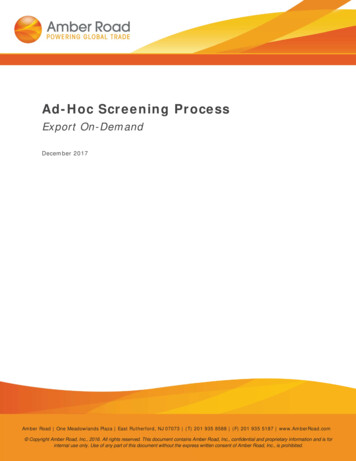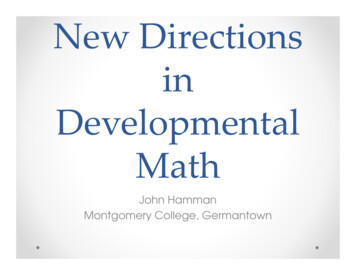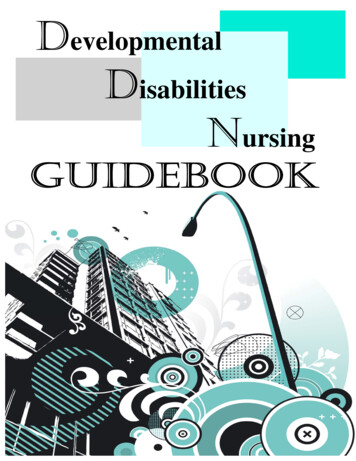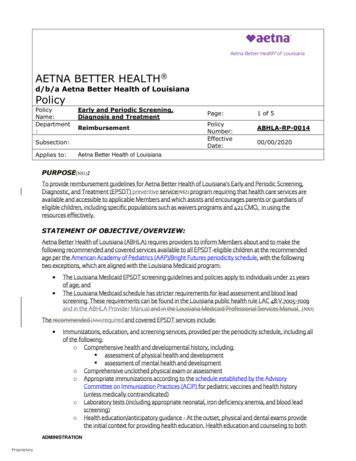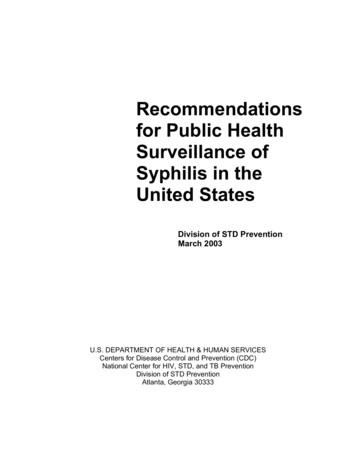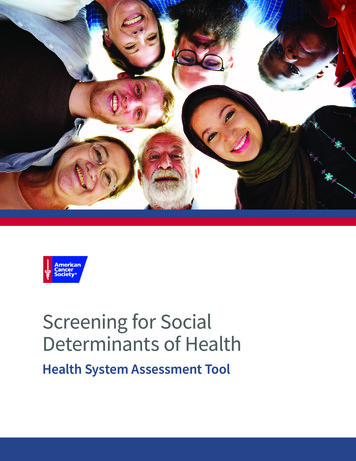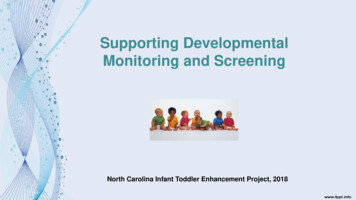
Transcription
Supporting DevelopmentalMonitoring and ScreeningNorth Carolina Infant Toddler Enhancement Project, 2018
Learning OutcomesTo recognize the importance of developmental andmonitoring screeningTo distinguish the difference between developmental andmonitoring screeningTo discuss effective communication strategies to use whentalking with parents about their child’s developmentTo identify resources to support parents
Early Intervention Matters Potential to produce more favorable outcomes thanremediation later in life Increases a child’s chances to make significant andpositive improvements in his or her development leadingto better long term outcomes
Let’s Talk About ItDevelopmental MonitoringDevelopmental monitoring means observing and notingspecific ways a child plays, learns, speaks, acts, andmoves every day, in an ongoing way. It often involvestracking a child’s development using a checklist ofdevelopmental milestones (www.cdc.gov/WatchMeTraining).
6 onthsWhat is a Red Flag?Some area(s) in a child’s developmenthas been recognized as falling outsidethe typical range of development
Developmental Indicators
Key Points-What We Want EarlyChildhood Educators to Know Developmental monitoring can help determine if achild’s development is on track and identify if earlyintervention services are possibly needed Early childhood professionals are in an ideal positionto monitor the development of all children in your care Knowledge of developmental milestones will alloweducators to effectively monitor children’s development
Let’s Talk About ItDevelopmental ScreeningDevelopmental screening is a brief assessment “intended toidentify children who are at risk for developmental problems”(as cited in National Infant/Toddler Child Care Initiative at Zeroto Three, 2010)
Importance of DevelopmentalScreening Roughly 13% of US children 3 to 17 years of age have adevelopmental or behavioral disability– Autism spectrum disorder– Language/speech delays– Intellectual disabilities– ADD/ADHD 1 in 4 children in the United States, ages 0-5, are at moderateor high risk for developmental, behavioral, or social delay A significant number of children with developmentaldisabilities are not identified before age 10Centers for Disease Control and Prevention: ing
Purpose for DevelopmentalScreening Help identify potential developmental issues in children thatmight otherwise go undetected Indicates whether further evaluation is needed Allow eligible children to receive intervention or specialeducation services American Academy of Pediatrics recommend screening at 9,18, and 24 or 30 months
Developmental ScreeningProcess Relies on a standardized screening tools that are consideredvalid and reliable Designed to be brief (30 minutes or less) Does not capture the full range of development and skills amongchildren Only indicates possibility of developmental delay-not a diagnosis Must be followed by a more comprehensive and formalevaluation process to confirm or disconfirm any red flags
Developmental MonitoringDevelopmental Screening‒ FormalAssessment– Conducted by parents,teachers‒ Ongoing processbegins at birth‒ Sample tool –”Learnthe Signs. Act Early”Milestones ChecklistLook fordevelopmentalmilestones‒ Recommended by theAmerican Academy ofPediatrics at 9, 18, and 24or 30 months‒ Uses a validatedscreening toolImportant fortracking signs ofdevelopment and ‒ Conducted by medicalprofessionals & teachers withidentifyingspecial trainingconcerns‒ Sample tool-Ages andStages Questionnaire
Developmental ScreeningTools Screening tools are designed to help identify children whomight have developmental delays Screening tools can be specific to a disorder such asautism, a specific area of development such as motordevelopment, or encompassing multiple areas of concern Some screening tools are used primarily in pediatricpractices, while others are used by school systems or inother community settingsSource: ml
Developmental ScreeningTools Screening tools do not provide conclusive evidence ofdevelopmental delays Screening tools do not result in diagnoses A positive screening result should be followed by athorough assessment and/or evaluation Screening tools do not provide in-depth informationabout an area of developmentSource: ml
NC Pre-Kindergarten Program All children enrolled in the NC Pre-K program are required toreceive a screening assessing the development of each child,across all domains, to ensure, unless the child has an existingIndividualized Education Program (IEP) The developmental screening shall be conducted by a healthcare, community or school professional trained in administeringthe screening tool The screenings shall be used for the purpose of identifyingchildren to be referred for further evaluation and testing basedon concerns in one or more developmental domains
Developmental Screening Tools Ages & Stages Questionnaires, Third Edition (ASQ-3) or Ages &Stages Questionnaires (ASQ) Brigance Early Childhood Screen II (3-5 Years) or Brigance HeadStart Screen or Brigance Preschool Screen – II, (under 4 years 11months) or Brigance K & 1 Screen – II (5 years 0 months andolder) or Brigance Early Childhood Screens III (3-5 Years or K & 1)or Brigance Head Start Screens III Developmental Indicators for the Assessment of Learning, ThirdEdition (DIAL-3) or Fourth Edition (DIAL-4) Parents’ Evaluation of Developmental Status (PEDS)
Ages and Stages Questionnaires Considered valid & reliable Use to identify children that might beat risk for developmental delay Series of questionnaires for childrenages one month to 5-1/2 years Take 10–15 minutes for parents tocomplete and 2–3 minutes forprofessionals to score
Key Points-What We Want EarlyChildhood Educators to Know Keep in mind that developmental monitoring is not thesame as developmental screening Developmental screening is typically done by a medicalprofessional and can be done by teachers with specialtraining Screening tools are designed to help identify childrenwho might have developmental delays
Communicating with FamiliesforClassroom Early Childhood EducatorsTips and Strategies Regularly talk to parents about healthy development Spend time building a trusting relationship withparents Be culturally sensitive Complete a milestone checklist Know your program’s policy on communicating withparents Have a clear understanding of the school/center’sreferral process
During the Meeting with Parents Highlight the child’s strengths Use a translator, if needed Be respectful Remember to consider cultural differences Honor confidentiality and privacy Make it a two-way conversation
During the Meeting with Parents Con’t Provide opportunities for parents to speak and askquestions Offer to assist connecting family with early interventionservices Provide any relevant contact information Remember parents know their children (they are theexperts)
Use Active Listening While talking to the parent, listen attentively and makeeye contact Sit quietly while the parent is speaking and nodoccasionally to reassure them you are still listening While you are listening to the parent, think about howthey might be feeling and acknowledge those feelings tothe parent with compassion Once the parent finishes speaking, paraphrase what theysaid and repeat it so they know you understand
What Would You Say?
Key Points-What We Want EarlyChildhood Educators to Know Make sure you are well prepared before talking toparents about their child’s development Regularly talk to parents about healthy development Strive to build a meaningful relationships with parents Use cultural sensitivity Use active listening while talking to parents Provide opportunities for parents to speak and askquestions
What is Early Intervention?A system of services provided to families with children ages birth tothree that are at risk of, or have some type of developmental delay ordisability.Why is it Important?Research indicates that early intervention treatment services cangreatly improve a child’s development.Individuals with Disabilities Education Act (IDEA)Part C of the IDEA provides services for young children with specialneeds, aged birth to three yearsPart B of the IDEA provides services for children/adults with specialneeds, aged 3-21 years(Centers for Disease Control and Prevention)
Early Intervention Systems inNorth CarolinaInfant-Toddler Program (ITP)(IDEA Part C)Local Lead Agency:Children’s DevelopmentalServices Agency (CDSA)Serves children birth to threeyears, with special needsPreschool Program(a part of IDEA Part B)Local Lead Agency:Local Education Agency (LEA); localschool systemServes children three to five years ofage, with disabilities. Five-year-oldswho are eligible for kindergarten are notserved through the Preschool Program
North Carolina INFANT-TODDLERPROGRAM(NC ITP)http://www.beearly.nc.gov/index.php/
Family Support Network ofNorth Carolinahttp://www.fsnnc.org/
Centers for Disease Controland PreventionLearn the Signs, Act l
Julie Clinkscale - NC ITQEP Education Managerjuliec@childcareservices.orgGinger Thomas - NC ITQEP Project Managergingert@childcareservices.org
Start Screen or Brigance Preschool Screen -II, (under 4 years 11 months) or Brigance K & 1 Screen -II (5 years 0 months and older) or Brigance Early Childhood Screens III (3-5 Years or K & 1) or Brigance Head Start Screens III Developmental Indicators for the Assessment of Learning, Third



